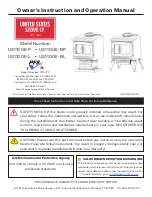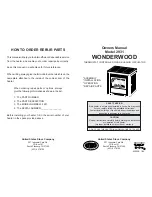
ASSEMBLY
STANDARD LEGS:
Attach the legs if required. We suggest that the two
legs with fixing holes be fitted to the back of the stove, for neater
appearance. If the hearth is uneven, fit one or more washers between any
leg and the stove body to lengthen it. Fix the stove down to the hearth,
through the legs, using the screws and plugs provided.
'AMERICANA' COOKTOP KIT OPTION
(supplied separately)
:
Remove
the two bolts located to the left and right inside the underneath of the
standard top. Remove and discard the standard top, taking care not to
damage the fibre seal. Fit the 'wings' to the cooktop and bolt the whole
assembly back onto the stove body. Do not over tighten.
'EUROPA' HI-LEG KIT OPTION
(supplied separately)
:
Assemble the left,
and right hi-legs
loosely
to the central bridging member. Attach to the
underside of the stove using the bolts supplied before fully tightening.
Note the 'Installation Clearances' on page 1. When used as a log store,
logs must not be placed higher than the central 'bridging' member.
FITTING
Rear flue connection into the
chimney with sealing collar.
Cleaning door on opposite
side.
Top outlet through fully-sealed
steel
closure plate (fitted with cleaning door)
into old, oversized, chimney with steel
sealing collar.
Top outlet with 45 degree bend
sealed into masonry chimney
with cleaning door on opposite
side.
Rear outlet connected to
top outlet by 'T' piece
with cleaning door, to
bring stove forward.
FLUE CONNECTION:
Fasten the flue outlet and blanking plate to the top or back flue outlet with screws and nuts provided. Tiger can
be connected to the chimney (using approved flue pipe components) in several ways, four of which are shown above. Whichever
method is used it is imperative that: (1) The route for gases from the stove to the chimney terminal is completely air-tight-seal all joins
with fireproof cement and/or heatproof rope. (2) It is possible to sweep the entire length- access doors may be required. (3) The entire
construction is of durable fireproof materials- composite board is
not
a suitable material for closure plates, which should be of steel or
concrete. Tiger should be secured to the hearth by bolting through the fixing holes drilled in the legs.
AIR SUPPLY
Tiger needs air to breathe - there
must
be a
permanent
air supply into the room in which the fire is installed equal to at
least 5.5cm² per kW heat output. While it is commonly accepted that this air for an appliance below about 5kW in an older (before
c1980) property can often be supplied by air naturally leaking around windows etc, in any case of doubt fit a fixed air vent. A extractor
fan, or another fireplace or heater can remove this air, even if fitted in a different room.
CO DETECTOR
Carbon Monoxide is a poisonous gas, produced by this stove. It is wise to fit a CO alarm near the stove.
LIVING WITH A TIGER
LIGHTING
Empty the ashes. Place two or three firelighters
close together, or screwed-up paper covered with dry sticks,
at the back of the grate and light them. When they are
burning well gently fill the fire
very full
with dry fuel, close the
door and set the air control slide to the 'high' (right) position.
To prevent castings from cracking, the first fire lit in your
Tiger should be small- made with little fuel and the air
slide set to 'low'.
FILLING:
When using mineral fuel, don't fill above the level of
the lining bricks.
CONTROL
How fast the fire burns depends on how much air
reaches the fuel. The Tiger+ has two air controls, one above
the window (the 'airwash control') and one below ('primary
control'). Move the slides to the right for highest output, to the
left for 'low'.
Our tests indicate highest efficiency on wood with the primary
control all but closed and the
airwash
2
/
3
open. Anthracite
works best with the airwash
closed and the primary
1
/
3
open.
But the best settings will
depend on your fuel, air supply
and flue draught and can only
be found from experience.
ECONOMY
Surprisingly, best
economy is achieved with the
firebox very full and the air
control set to 'low'. The fire will
burn much more efficiently than if you use 'little and often' and
will need less frequent refuelling.
2






















